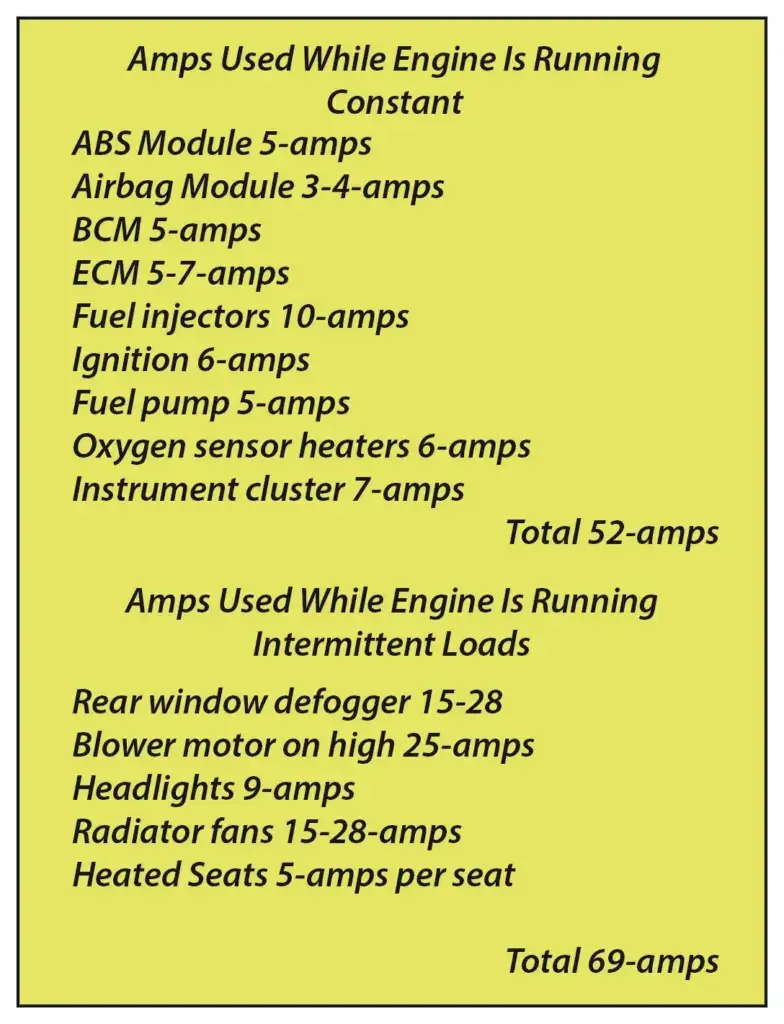How many amps a car uses while running
Your car uses a lot more power than you think — Here’s how many amps a car uses
Back in the old days before computers the highest current draw items were the blower motor and windshield wipers. The fuel pump was mechanical and the ignition system drew maby 4-amps. If you didn’t use the blower or the wipers, maybe you’d use 8-amps while running. Not anymore. Modern cars demand lots of power. Take a minute to see how many amps a car uses while running.
All of these electronic components draw power when the engine is running

That’s 52 amps (on the low end) and that doesn’t even count any ADAS power for blind spot radar. collision avoidance modules and cameras and radar/lidar.
Add up how many amps a car uses with this chart.
ABS computer current draw
In a driving state with no ABS activation, the computer draws about 5-amps. During ABS operation it can draw up to 50-amps.
Airbag control module current draw
In a monitoring state, the airbag control module draws less than 10-amps
BCM Body Control Module current draw in amps
In idling mode (no brake lights, headlights in use) computer draw only 5-amps
ECM computer amperage
A typical ECM draws slightly less than 10-amps
Fuel Injectors current draw
Gasoline Direct Injectors draw approximately 10-amps
Port Fuel Injectors – 4 to 6 amps peak, 1 amp hold
High pressure fuel pump (for direct injection engines
A high pressure fuel pump for direct injection engines doesn’t actually use an electric motor to produce pressure. It’s a mechanical pump that rides off the camshaft to produce up to 2,000-psi for direct injection. But it does use power to control the inlet/outlet port solenoid. The solenoid opens the suction port to allow fuel to enter and then closes to allow the pump to compress the fuel.
Ignition system need in amps
Old single coil ignition systems – 3 to 4 amps.
Distributorless Ignition Systems – 5 to 6 amps at peak output.
Coil-on-plug ignition systems – 6 amps per coil at peak output.
Ignition System (primary circuit) – 6 to 20 amps.
Instrument cluster amps usage
A typical instrument cluster consumers approximately 7 amps
In-tank fuel pump current usage in amps
In general, in-tank fuel pumps draw is approximately 1 amp for every 10-psi of fuel pressure. So a port injection system that requires 45-psi. will consumer approximately 4.5 amps. But consumption varies based on the fuel needs of the vehicle speed and load. So figure 4-6-amps for a port injection engine.
Oxygen sensor heater amps usage
Oxygen sensor heater current draw depends on the type of sensor, whether it’s a wide-band or narrow-band sensor. But in general, oxygen sensor current usage ranges from .2 to 8-amps per sensor.
Radiator fans current draw in amps
A single radiator fan can draw from 15-28 amps. A dual fan setup can run up to 35-amps.
Rear window electric defogger current draw
Electric Rear Window Defroster – 10 to 20 amps
TCM Transmission Control Module
Shift solenoids are pulse width modulated so current draw varies based on driving conditions.
Then there’s the accessories.
Headlight current draw in amps
Halogen Headlights low beam- 8 to 9 amps per pair
Halogen Headlights high beam – 9 to 10 amps per pair
Halogen Headlights high and low beams combined) – 17 to 19 amps
Xenon HID Headlights – 12 to 14 amps during initial startup, then 7 to 8 amps to maintain arc
LED Style Headlights – 0.6 to 1 amps per bulb
Heated seats current draw
Heated Seats – 3 to 4 amps per seat
High pressure fuel pump (for direct injection engines
A high pressure fuel pump for direct injection engines doesn’t actually use an electric motor to produce pressure. It’s a mechanical pump that rides off the camshaft to produce up to 2,000-psi for direct injection. But it does use power to control the inlet/outlet port solenoid. The solenoid opens the suction port to allow fuel to enter and then closes to allow the pump to compress the fuel.
High end sound system current draw in amps
A 500 Watt Sound System – 13 to 30 amps
Ignition system need in amps
Old single coil ignition systems – 3 to 4 amps.
Distributorless Ignition Systems – 5 to 6 amps at peak output.
Coil-on-plug ignition systems – 6 amps per coil at peak output.
Ignition System (primary circuit) – 6 to 20 amps.
Instrument cluster amps usage
A typical instrument cluster consumers approximately 7 amps
In-tank fuel pump current usage in amps
In general, in-tank fuel pumps draw is approximately 1 amp for every 10-psi of fuel pressure. So a port injection system that requires 45-psi. will consumer approximately 4.5 amps. But consumption varies based on the fuel needs of the vehicle speed and load. So figure 4-6-amps for a port injection engine.
Electric Fuel Pumps – 4 to 12 amps (max)
Oxygen sensor heater amps usage
Oxygen sensor heater current draw depends on the type of sensor, whether it’s a wide-band or narrow-band sensor. But in general, oxygen sensor current usage ranges from .2 to 8-amps per sensor.
Radiator fans current draw in amps
A single radiator fan can draw from 15-28 amps. A dual fan setup can run up to 35-amps.
Rear window electric defogger current draw
Electric Rear Window Defroster – 10 to 20 amps
TCM Transmission Control Module
Shift solenoids are pulse width modulated so current draw varies based on driving conditions.
©, 2024 Rick Muscoplat
Posted on by Rick Muscoplat